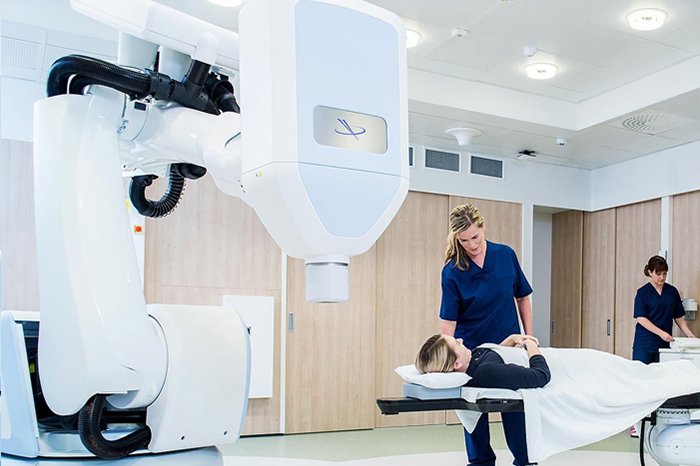Welcome To Valentis Cancer Hospital
Valentis Cyberknife Centre
Cyberknife S7 Robotic Radiation Therapy
First in India

What is a Cyberknife S7 Robotic Radiation Therapy ?
The Cyberknife S7 Robotic Radiation Therapy System is a non-invasive alternative to surgery for the treatment of both cancerous and non-cancerous tumours in the (prostate, lung, brain, spine, liver, pancreas, and kidney) and non cancerous tumors. The therapy, which delivers high-dose radiation beams to tumours with pinpoint accuracy, gives patients around the world new hope.
Although the name conjures up images of scalpels and surgery, the CyberKnife S7 treatment does not involve any cutting. In fact, the CyberKnife S7 System is the world's first and only Robotic Radiation Therapy system designed to treat tumours throughout the body non-invasively. It offers a painless, non-surgical option for patients with inoperable or surgically complex tumours, as well as those seeking an alternative to surgery.
In this technology, a robotic arm is used to focus the radiation rays with any part of the body. A Lightweight Linear Accelerator, abbreviated as LINAC, is used in conjunction with a Robotic arm to provide views from various angles.
What makes Cyberknife S7 Unique
- Unrivaled accuracy: The CyberKnife S7 system can treat moving tumours with pinpoint accuracy that other radiation therapy systems cannot match. This is especially important when treating tumours that move in response to any bodily function (e.g., breathing).
- Unrestricted flexibility and freedom: The robotic maneuverability of the CyberKnife S7 system enables doctors to deliver highly personalized treatments. CyberKnife S7 clinicians at Valentis can select various angles targeting the tumour with a high dose of radiation from every conceivable angle using a linear accelerator mounted on a flexible robotic arm.
- Real-time image guidance: The CyberKnife S7 employs a sophisticated 6D image guidance system to track and adjust treatment in response to any movement of the patient or tumour.
- Convenient: Depending on the type of tumour, patients typically require one to five CyberKnife S7 treatments, which typically last less than 30 minutes, whereas other radiation systems require dozens of treatments spread out over several weeks.
- Patient safety: The CyberKnife S7 is a fully integrated closed-loop system, unlike other gantry-based linear accelerators. Each function collaborates to provide the safest possible patient experience.
Getting Ready for Cyberknife S7

Evaluation: Following a diagnosis, Valentis doctors team may recommend CyberKnife S7 treatment based on the patient's specific needs. A team of Valentis doctors, including radiation oncologists, medical oncologists, and surgeons, as well as medical physicists, radiation technicians, and nurses, collaborate to develop the patient's care plan.

Imaging and treatment planning: Prior to beginning treatment, an MRI, CT, or CT/PET scan is performed to determine the size, shape, and location of the tumour. The images from these scans are digitally transferred to the CyberKnife's treatment planning workstation, where Valentis specialists identify the tumour to be targeted and the vital structures surrounding it to be protected. The strategy is intended to match the desired radiation dose for the tumour while limiting exposure to surrounding healthy tissue.

Fiducial placement: Fiducials (small golden markers) are inserted to determine the exact location of the tumour, depending on the type and location of the tumour.
Cyberknife S7 Can Treat
CyberKnife S7 is used as a boost for residual or recurrent cases of malignant gliomas or glioblastomas after surgery. Neuromas arising from other nerves, pituitary adenomas, hemangioblastomas, meningiomas, and hemangiopericytomas are all potential candidates for CyberKnife S7 radiation therapy.
CyberKnife S7 is an excellent option for sparing the normal spinal cord with greater precision than most other radiation delivery techniques. The CyberKnife S7 can deliver highly focused radiation to spinal tumours, sparing the surrounding normal tissues to a much greater extent.
The prostate moves unpredictably as air passes through the rectum and the bladder empties and fills, making radiation treatment of prostate tumours difficult. Valentis 's CyberKnife S7 Robotic Radiation Therapy System is able to overcome this challenge by continuously identifying the exact location of the prostate in real-time during treatment and making active corrections for any prostate movement during the course of the radiation delivery. During treatment, the patient remains motionless and breathes normally while the CyberKnife S7 zeroes in on a moving target, the prostate, and irradiates it without causing harm to the surrounding areas.
As a result, patients are more comfortable during the procedure, radiation is delivered more precisely, and treatments can be completed in three to five sittings. Currently, the CyberKnife S7 Radiation Therapy System is most commonly used as a single modality for early cancer treatment.
Currently, the CyberKnife S7 Radiation Therapy System is most commonly used as a single modality for early organ-confined prostate cancers or as a boost in cases of advanced or intermediate-stage prostate cancer. Depending on the patient's prostate cancer stage
Because liver tumours move with respiration, treating liver cancer with radiation therapy is difficult. Furthermore, the tissue surrounding the liver tumours is extremely sensitive and easily damaged. Valentis 's CyberKnife S7 Radiation Therapy System can deliver extremely high doses of radiation to both primary (before or after a liver transplant, or in conjunction with chemotherapy or other treatments) and metastatic liver tumours. The Synchrony Respiratory Tracking System, which works in tandem with the CyberKnife S7 System, allows the radiation beam to track tumour movement in real-time while allowing patients to breathe normally .
When treatment is limited to a small area, CyberKnife S7 can be used as an alternative to radical surgery in early stage lung cancer. When your Valentis Oncologist determines that your Lung Metastasis or post-primary therapy limited residual or recurrent disease can be targeted by the CyberKnife S7 machine, CyberKnife S7 is also useful. The advantage of CyberKnife S7 is that it delivers a radical ablative dose that can control the disease in a completely non-invasive manner. It has the unique ability to track the tumour while it is breathing, allowing it to be treated with minimal extra margins and thus reduce side effects very efficiently.
To reduce the dose going to the vital areas and subsequent side effects, CyberKnife S7 can be used as a boost to a small critical area close to the eyes or other vital areas. CyberKnife S7 is also indicated for residual and recurrent disease after primary therapy, as well as neck node residual or recurrent disease.
CyberKnife S7 can sometimes be used as a very short-course radiotherapy that only targets the postoperative surgical site in localised early-stage breast cancers. It is, however, only possible in certain cases, and only the treating oncologist can make this decision based on all available records and the patient's stage. CyberKnife S7 can also be used in metastatic cases where the disease has spread from the breast to other organs such as the lung, brain, bone, or liver and is still limited in number (6) or size (6 cm). It cannot be used if a severe and widespread disease exists.
Frequently Asked Questions
CyberKnife is a non-invasive robotic radiation therapy system used to treat tumors and other medical conditions. It delivers high doses of radiation with pinpoint accuracy, minimizing damage to surrounding healthy tissue.
CyberKnife uses real-time imaging and robotic technology to precisely target tumors from multiple angles. It tracks the tumor's position during treatment, adjusting the radiation beams to account for any movement, ensuring accurate delivery.
CyberKnife can treat various types of tumors, including those in the brain, spine, lung, liver, pancreas, prostate, and more. It is also used for conditions such as trigeminal neuralgia and arteriovenous malformations (AVMs).
CyberKnife offers several advantages, including precise targeting of tumors, minimal damage to surrounding healthy tissue, fewer treatment sessions compared to traditional radiation therapy, and minimal side effects.
Treatment sessions typically last between 30 minutes to an hour, depending on the size and location of the tumor. Most patients require multiple sessions spread out over several days or weeks.
Side effects of CyberKnife treatment are minimal compared to traditional radiation therapy. Some patients may experience temporary fatigue, skin irritation, or mild discomfort, but these side effects typically resolve on their own.

